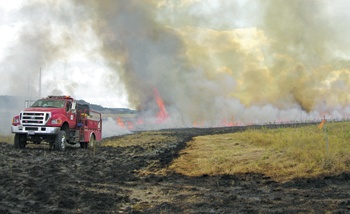Minutes before the brushfire is lit, research scientist Mark Simmons kneels on the ground at the Lady Bird Johnson Wildflower Center, whipping a psychrometer around like a slingshot to measure the humidity and air temperature. He raises a hand to test the wind speed and direction. It’s a go for burning. He speaks into a walkie-talkie to his eight-member burn team and says, “Ignite.”
Safely clad in yellow fire-retardant shirt and pants, one member of Simmons’ team traces a thin black line of fire across the grass, holding a gas and diesel drip torch like a paintbrush. The fire creeps slowly into the southward wind.
Snowflake-like bits of gray ash fly skyward above the brushfire. I stand only 20 feet from the fire as it hisses and crackles and takes on a life of its own. And though I feel the heat, smell the acrid smoke and stare right in the face of a soon-to-be-roaring brush fire, I don’t feel fear, only awe—a wonder that a deliberately set fire is so controlled.
Setting “prescribed fires” is a frequent happening at the 279-acre Lady Bird Johnson Wildflower Center, part of the University of Texas at Austin, which since 2001 has been conducting these carefully prescribed burns on its grounds southwest of Austin. The aim of the Hill Country Research Project is to observe burning in multiple-weather seasons and demonstrate the amazing efficiency of a burn to restore native ecology.
“Prescribed fire is an ideal solution to the environmental problem of invasive species,” says Simmons, the “burn boss” for this day’s fire. “Fire is just copying nature,” he notes, referring to times when fires, lit by lightning, roared across the Texas landscape. Sometimes, Native Americans deliberately set the blazes. The result was verdant new growth for the buffalo that munched and grew fat off local grasses. “Native grasses are like ice cream to cattle today,” Simmons says.
Other yellow-suited team members patrol the perimeter of the fire to stamp out small fires creeping out of the fire line. They swat at the fire in a mopping-like motion using truck mud flaps attached to broom poles. Meanwhile, Simmons circles the acreage in a four-wheeler, calling to his crew on the walkie-talkie. He instructs the fire line to be laid from the northeast to the southeast corner and then another line counterclockwise on the other side of the acreage—fire goes with the wind toward the center of the acreage where it will whoosh up in a big convection fireball.
This acre-and-a-half burn is done on land representative of the Texas Hill Country—a field of short grasses (both native and non-native), forest-green Ashe junipers (mountain cedar), live oaks with grapevines streaming downward, ubiquitous scrub brush, agarita and, finally, the ever-present prickly pear cactus.
Prescribed fires are but one method used to restore the native ecology of the land—and they are a more economical and effective way than either the use of pesticides or tilling to destroy invasive plants, both non-native and native, that have, thanks to overgrazing, farming and encroachment of suburbia, almost destroyed native prairies. Less than 1 percent of historic tall-grass prairie remains in Texas.
Burn researchers at the Wildflower Center were pleasantly surprised to learn that summer burns are especially effective for killing off King Ranch bluestem, a Eurasian native that chokes out native grasses. The natives have a higher protein content prized by ranchers for their cattle.
There’s a larger effect from a prescribed burn—a direct effect on global warming.
“Native grasses, like forests, act like lungs, filtering out carbon dioxide from the atmosphere and putting oxygen back into the air,” explains Steve Windhager, director of landscape restoration for the center. Studies have shown that the new grasses absorb much more carbon dioxide than what a burn emits. “So there is not as much going up in smoke as you might think,” he says.
In addition, he says, “A burn is one part of proper land management, which helps native plants filter out pollutants from rainwater before it flows into nearby streams and aquifers.”
Center staff frequently are asked, how can prescribed burns be safe? “Because they are conducted with military-like precision,” Simmons explains. “There are no second guesses; all factors have to be exact.” Indeed, as the designated burn boss, Simmons files a burn prescription with the Austin Fire Department specifying that temperature, humidity, vegetation moisture and wind speed will fall within a prescribed range.
“A prescribed fire is safer than driving a car,” Simmons says. And, besides, the team has a 200-gallon water tank truck on standby—and because this burn is inside the city limits, the fire department, at no cost to the center, parks a red fire truck by the site, ready—although it has never been needed.
And what of the uncontrolled wildfires that are so predominant in some dry years, particularly in California? Windhager says, “Ecologically, the fires in California are not catastrophic. The real problems there come from property damage, which prescribed fires also minimize.”
Lady Bird Johnson never got to see a burn at her beloved center, but Windhager, who knew the former first lady (she co-founded the center with actress Helen Hayes, a friend, in 1982), believes Johnson would have delighted to see ash and smoke soar upward, fulfilling her dream for research about one more method with which to restore and preserve native plants to all of America.
——————–
Mary Lance is a writer based in San Antonio.


